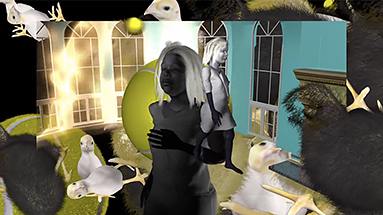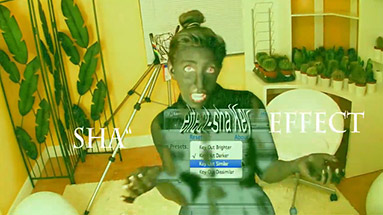Ryan Trecartin's films defamiliarize contemporary culture without casting explicit judgment
“Earthlings now live in a kindergarten grotesque.” –Rem Koolhaas, “Junkspace”
From a windowless warehouse—part-TV studio, part-bunker—they rehearse what it was like to have been human. Wearing a blonde wig they croon, Sororrrityyy, yeah! and lock into an AutoTuned groove with two harmoniously costumed, likewise gender non-conforming companions: I said do I sound goood? Yeah, you sound real gooooood. Nearby, a boyish presence coordinates the placement of toilets in an artificially lit space filled with fog, mirrors, spotlights, chains, cinder blocks, tubs, and trampolines. Masked in dark, dichromatic makeup, he brandishes a camera as he protests his hominid anatomy: “I have two feet and two hands. It’s really normal!”
This all-too-human body belongs to Ryan Trecartin. In Comma Boat (2013), one of four new videos by Trecartin that had their U.S. premiere at the annual film and video art festival “Migrating Forms” in December, the artist plays a domineering director with a grudge against people and those who study them (“Hey, mister anthropologist bullshit face!”). His character boasts of embracing a new, hyper-visual form of writing: “I don’t believe in journals anymore—I write things on the back of my eye.” The director and his cast (including regular collaborators Alison Powell, Lee Kyle, Telfar Clemens, and Rhett LaRue) clumsily attempt to flee corporeal constraint and purge themselves of human behavior. Lacking traction or agency, however, they remain trapped in what Rosalind Krauss once called “the prison of a collapsed present.”
In her influential 1976 essay “Video: The Aesthetics of Narcissism,” Krauss argued that because video receives and produces imagery at the same time, offering the instant feedback of a mirror, the medium’s defining quality is narcissism. It’s a barb that has often been leveled at Trecartin, perhaps the most prominent video artist since the computer screen superseded the TV as display. Yet for every critique of his videos as self-obsessed, cynical, or superficial, Trecartin has been the subject of still more deserved praise. He has been labeled “the most consequential artist to have emerged since the 1980s” (by New Yorker art critic Peter Schjeldahl) and lauded in more extravagant terms by critics who tout his work as the oracular revelations of a Millennial back from Planet YouTube. “If there were a Spirit of the World Wide Web,” wrote The Daily Beast’s Blake Gopnik, “Trecartin would be its medium on earth.”
Fulfilling the role of an emissary from another dimension, Trecartin acts as a conduit for the culture industry’s most prized abstraction: the contemporary. He is seen to personify the present as reflexively as a medium in the technical and parapsychological senses that Krauss evokes. Yet despite his intellectual synchronicity with the Internet, Trecartin’s videos are not mirror reflections of either himself or his era, but critical recalibrations of tech-inflected neoliberal culture.
Trecartin’s world is populated by tweens, teens, and twenty-somethings; posses of material girls—plus the occasional boy; and flocks of post-material queens and clones. His characters have not only separated their actions from bodies, but also from selfhood as anything but perpetual, spontaneous becoming. The stable self disperses into first-person situations. History is substituted by the caption “Happening Now.” Template states of personhood and place, presets and premises, are manipulated by anonymous agencies. Feelings are ambient facts. Emotion exists externally, separate from subjects, as affect.
Non-linear editing technologies command Trecartin’s cast with inescapable force. In their more lucid (or paranoid) moments, the characters chatter about the digital protocols to which they are submitted as fluently as today’s humans might complain of a life-sucking job. Through aphorisms poised between brilliance and garble, and makeshift costumes that accentuate their feverish speech and evanescent identities, these cyborgs articulate a provisional worldview suspended in simultaneity, reversibility, and co-presence.
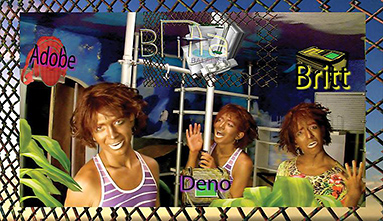
Trecartin’s unworldly creatures chat about “placebo events” and “digital migration.” They order off-screen presences to “refresh the room,” or realize that they have been remotely edited. They mask themselves with makeup: whiteface, office-face, composited face. Familial, ethnic, and gender affiliations are obscured, in name as in face. Trecartin’s appellations, often temporary, merely index situations, pointing to fields of action: Flow Stopper, Mass Major, Carryon Ova, Wait, Y-Ready, Retina, Roamie Hood, JJ, Able, Twi-Key, I-Be. Like Pynchon’s punning personages, from Oedipa Maas and Pierce Inverarity to the Traverses and the Vibes, these monikers encode meaning at many layers, alternately emphasizing the characters’ symbolic roles within a set of circumstances, alluding to their technological or cultural determinants, or metonymically referring to the objects, moods, or situations that surround them.
If Trecartin’s characters are post-human, they are also, as critic Nancy Princenthal observed in an astute essay, post-erotic (a quality that distinguishes them from Kalup Linzy’s closely related drag personae). Instead of making love, they hump the floor beside an interlocutor they hardly seem to notice. “I don’t believe in sex—just the drama around it,” proclaims one of the artist’s many fleshless incarnations. In keeping with Slavoj Žižek’s evocation of “products deprived of their malignant property: coffee without caffeine, cream without fat, beer without alcohol,” their pleasure, however pervy or loud, never gives rise to pain. Drugs of choice include energy drinks and “personality samples”: substances, real or imagined, associated not with escape or excess, but enhanced performance. The preferred liquor is Listerine. And though they may take hammers to mirrors and windows or razors to their wrists, there’s no harm done. Blood is a red Sharpie marker—and there’s always more shit to smash.
Smashing shit is the leitmotif of Junior War (2013), which provides the surprising source material for Trecartin’s latest (and still incomplete) body of work—surprising because the artist shot the footage as a high school senior. Edited for the 2013 Venice Biennale but recorded in rural Ohio in the fall of 1999, the movie focuses a night vision-equipped camera on a backwoods rager and the imbecilic, gleeful pranks it unleashed. Trecartin purchased his camera after seeing The Blair Witch Project that summer, and occasional citations of the lo-fi blockbuster (a camera light forging a path through the brush or illuminating a pale, fearful face) find their way into Junior War. But Trecartin has turned his erstwhile horror-documentary into a Jackass-style comedy featuring a cast of white American teenagers doing what teenagers living in the middle of Nowhere, America will do: smoke spliffs and shotgun beers, puke and wipe up one another’s puke, TP trees and bash in mailboxes, all the while bragging about what they’d tell the cops.
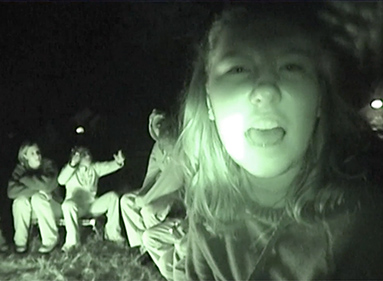
Digitally spliced with virtuoso skill, Trecartin’s footage of unremarkable adolescent hijinks is transformed into a riveting semi-narrative montage. Junior War lends underage partying an oneiric, lyrical quality, a pairing of subject and mood last seen in Harmony Korine’s Spring Breakers. Rife with extended cross fades that convert everyday gestures into dream imagery, and shots of street lights reflected into sublime symmetries, Junior War evokes the visual world of ‘90s music video auteurs like Michel Gondry or Jonathan Glazer. Footage is glued together—as in the more recent genre of the supercut—by iterations of a phrase the subjects adopt as their imperative: fuck shit up.
Repetition is Trecartin’s primary deconstructive tool, doing the work of defamiliarizing contemporary culture without casting explicit judgment on it. Contributing to his depiction of the self as a fluid set of performative subject-positions, repetition is also linked to the centrality of auditioning, from orphans who rehearse their desirability for adoption in I-Be Area (2007) to the “audition item” who boasts, “I audition better, faster, further, and more complicated than a horse” in Item Falls (2013). In an exquisite essay on Trecartin, “Situation Hacker,” Wayne Koestenbaum observed that the artist’s characters are “always auditioning for Presence.” But if the audition represents “a perpetually stimulated and vigilant state of being” for Koestenbaum, implying critical consciousness, it appears as the involuntary, ineluctable process of Althusserian interpellation in Junior War.
Plotting mischief from a parking lot, one of Junior War’s many anonymous dudes follows the rallying cry “Let’s fuck shit up” with momentary doubt: “That’s the phrase, right? ‘Fuck shit up’? I got that right?” These characters are auditioning for life as they suppose it should be lived, coming of age by learning to pronounce ideological discourse and modulating it according to social cues. In this “junior war,” two girls wrestle and trade barbs: “You slut!” “Ruth just called you a foreigner!” A few guys plant an American flag into the ground, approaching a subversive limit and pulling back with enough machismo to stay cool: “We’re not lighting it, shut the fuck up.” The meaning of freedom is considered: “Hey dude, I deserve as many rights as you do.”
The title Junior War anticipates the military references and paraphernalia, chiefly riot gear, strewn throughout Comma Boat and CENTER JENNY (also 2013). These movies take place in the wake of a war, after humans have ostensibly evolved into “animations.” Students in bikinis learn about their corporeal ancestors in an inane, misogynistic university where they piece together insights such as, “The further we all move away from humanity, like, sexism becomes the coolest style... because tolerance is inevitable, right?” They’re affirmed by male teachers who aver, “I wrote the foundation to everything you ever articulated.”
The war figures as a foundational rupture even as its details never surface. Asked “How can you tell which way is north?” one of the Jennys in CENTER JENNY responds, “Because my ancestors outlived the war.” According to a panicked “basic Jenny,” martial law now reigns and private property is under threat. But these sorority girls put up a tough front. Together with sweaters that read W4$T3 (as in “I’ll fuckin’ waste you, bitch”), they sport pink, feathered contraptions with razors they call “weaponized earmuffs” which likewise seem to spawn their own threat: “I’ll fuckin’ weaponize your territory.”
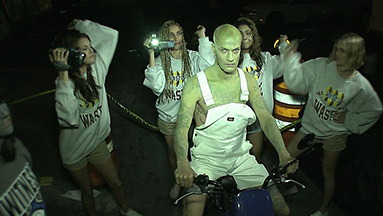
Trecartin’s combination of cute and menacing is smartly attuned to contemporary visual culture, but his jibes at a war—oddly singular, given the borderless, undeclared wars endlessly waged by the United States—seem oblivious to present-day systems of occupation, surveillance, policing, and incarceration. The artist may label his characters’ political naiveté parody, but his own recent work has thematized the neoliberal effacement of history more incisively.
With the 2009-2010 series of videos “Any Ever,” Trecartin accomplished this by accessing real historical events, albeit through simulated zones and states, from more structured scripts. In Roamie View: History Enhancement (Re’Search Wait’S), for example, he played a character named JJ who has regressed to “factory presets” and now finds everything cute or neat—at least, everything from the analog past: wheelchairs, snail mail, the U.S. Constitution. JJ even gawks at a printout of The Life, Trial, and Execution of Capt. John Brown (1859), the earliest narrative of the insurgent abolitionist’s life, and calls it “super cute”: “Um, it’s about how there once was a time where cute people had to do very real things to make their situation work out.”
However facile his speech, JJ’s misreading of the document’s title as “The Life and Captions and Execution of John Brown” actually intimates how the “very real things” that constitute radical politics have eroded into the stuff of myth (“there once was a time”). The judicial “trial” elided in Trecartin’s script signals the absence, in a digital environment characterized by identity and history “enhancement,” of the gravity and finitude of law. Meanwhile its replacement by “captions” undoes the punitive, lethal connotation of “execution,” which comes to mean the carrying out of a computer program. Where the phrase "Life, Trial, and Execution" describes an existential passage through trying times that end in state-sanctioned death, its substitute “Life, Captions, and Execution” posits subjectivity as software to be managed. John Brown, like JJ, is only a program.
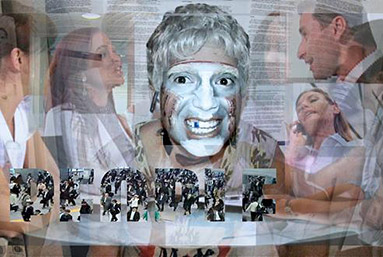
The artist has described his avatar JJ’s signature utterance, “cute,” as “data and idea compression.” When JJ calls John Brown, the postal system and the Constitution “cute,” he’s summing up U.S. history as if it could be compressed into a .gif image or a time-lapse video. But labeling something “cute” is also “a way of aestheticizing powerlessness,” in Sianne Ngai’s words, that “hinges on a sentimental attitude toward the diminutive and/or weak, which is why cute objects…get even cuter when perceived as injured or disabled.” In this regard, it is noteworthy that JJ bought his John Brown poster from a girl named Able (Lizzie Fitch), who also gave him a “Disabilities Act painting” she would like people to look at as they sit in wheelchairs. Unable to find any wheelchairs online, JJ concludes that the Disabilities Act painting is a “cute relic,” like people—those more vulnerable than Able—themselves: “See, I think that people are really cute.”
Human evolution has been a prevalent theme of Trecartin’s work for at least a decade, since he and Fitch made What’s the Love Making Babies For? (2003) as juniors at the Rhode Island School of Design. If “Any Ever” reached across U.S. history to examine the formation of a global corporate subject, his latest videos both cover a wider period—in silly evocations of dinosaurs turning into chickens—and investigate the narrower cultural and technological distance between the era Junior War documents and the present. Speaking to Art in America last summer, the artist said of his early footage, “People had a very different relationship to the camera [in 1999]. They didn’t want to be filmed. Then they either forgot the camera was there, which doesn’t happen now, or they narrated what they were doing.”
Indeed, Junior War is littered with urgent pleas to “Shut it off!” but also punctured by defiant challenges: “Record this.” In either case, the camera’s presence is conspicuous, even suspicious. If it’s difficult to imagine that casually snapping shots of friends was so recently an uneasy experience, Trecartin reminds us that recording and broadcasting ourselves felt alien before iPhones became extensions of our limbs, and YouTube and Instagram served as corrective lenses supplementing our eyes with collective vision.
In devoting his attention to “how people’s relationship to the camera used to be really primitive,” however, Trecartin has sacrificed a more nuanced exploration of contemporary surveillance. In CENTER JENNY, two puerile presences reminisce about “capitalism from the era of humans” while perched atop toilet seats. After one of them rhapsodizes, “Even when you be suckin’ them boyfriends’ dicks, you’ve still got them titties in your face—and they record it, all of it,” his accomplice responds, "They record all of it?" and the two erupt in joyful disbelief: “THEY RECORD ALL OF IT!?!” It’s a great comic moment. But with the rise of the surveillance state, the exclamation “they record all of it” might be better served by an insinuation of who "they" were and all that "it," besides fellatio, encompassed. The video would also benefit by linking the social drive to “broadcast yourself,” as YouTube would have it, to the institutional deployment of image capture technologies.
As a counter-example, artist Zach Blas’s video Facial Weaponization Suite: Fag Face (2012) explores the inequalities perpetuated by biometric facial recognition technologies used by states and corporations as tools of crime prevention, population control, and advertising. Taking a more explicit position of resistance against normative conceptions of gender and the profiling of activists and people of color, a computer voice advocates “weaponizing the face through masks” generated by the biometric data correlating to queer men’s faces. The resultant pink amorphous blobs render those who wear them perceptible only as a defiant collectivity, in the fashion of Anonymous, Pussy Riot, and the Zapatistas.
Trecartin’s new videos lack not only a more incisive portrayal of surveillance culture, but also the expansive layering of media technologies for which he is known. Handheld cameras are everywhere visible, but they never regain their once uncanny aura. In part, this failure to defamiliarize today’s technologies of vision arises from Trecartin and sometime co-editor Fitch’s decision to preserve real time, rather than shoot only to have abundant material to sample in post-production. It is as if Trecartin has, like the character he plays in Comma Boat, proudly abandoned writing—a temporal process bound up with the act of documenting history—for instantaneous recording. These shifts away from writing and editing not only have regrettable political consequences, but also result in a relatively homogenous temporal and visual palette that cannot sustain the animating tensions found in I-Be Area or “Any Ever.”
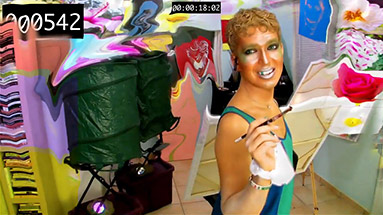
Take the scene in Ready (Re’Search Wait’S), 2009-2010, where Frush (Taya Koschnick) declares: “My mother accused me of being nothing but accumulation posed as existing free will. I said, listen, skank, I am in flow; accumulation is your hang-up. Refresh your memory, apply, and let go.” As Frush delivers this retort, positing an in-flux identity through the analogy of a neurotic human and a web browser that needs to be reloaded, JJ paints her portrait while Trecartin (as editor) manipulates the scene, adding an image of seeds exploding in atomic cloud formation, a bubble, mask icons and other camouflaging effects. Although these tricks result from post-production editing, the radical alterations in characters’ images are attributed to JJ’s paintbrush. In this coupling of video and painting, the latter’s fluid materiality becomes a visual representation of the former’s conceptual foundation in the notions of total flow and instantaneous feedback. The two mediums are both seen to shape and distort the human figure, while the spectacle of our bodies yielding to the commands and capabilities of our software appears on the horizon, portended by the incursion of computer technologies into our speech and consciousness.
The vivid portrayal of bodies digitally manipulated by the artist as video editor and his character as painter raise the stakes of image production as evolution in a way his recent body of work fails to push forward. Trecartin’s conception of history, intertwined with his representation of the human body as a framework to surpass, remains an ideological analogue to non-linear video editing. He regards the activity of editing his own image, and those of his friends, as a prelude to a situation in which humans will be able to modify their bodies and environments in situ: “I think we’re slowly moving to a point where we will visually manifest at the speed of creative thought, where as we’re saying an idea we are also changing our body and changing our scenery” (PDF). In a 2011 interview with Fillip, he stated:
In the same way that gender has slowly separated from the genitals one is born with, accent is separating from geographic inheritance, race is separating from DNA, mentalities are separating from class and culture... this can be applied to much of what we see as fixed, consistent, authoritative realities. I think it will be healthy for us to see ourselves as people first, and for everything else to be tools of expression. I hope it will someday be possible to truly liberate ourselves into a state where expression is existence and the accumulation of our situations become more of a catalogue of our identity rather than a written history. Maybe our personalities can be the location rather than our bodies. It would be great if the body could be utterly neutral and malleable.
This vision of total autonomy, a myth of radical freedom that appears at once utopian and dystopian, reveals not only an unsurprising share of technoromanticism, but also a certain naive faith in the possibility of an emancipatory existentialism that disregards the force of political structures. When Trecartin proposes that we “liberate ourselves into a state where expression is existence,” one wonders, again, who the agents of such liberation will be. In suggesting that we can transcend the social constraints of race, class, and gender, and eliminate bodily limitation altogether, Trecartin appears to embrace today’s ubiquitous libertarian fantasies of technological solutionism.
Technocratic liberal ideology is still haunted by the specter of eugenics. If humans have the capacity to forge other humans, in the virtual as in the material world, then surely biopolitical questions inflected with histories of racial and class oppression should precede celebrations of emancipation via technology. Put differently, who edits and who gets edited? Recall Twi-Key (Courtney Malick), also from Ready, who is colored black, from the dress and shoes she wears to the paint applied to her face and limbs. Twi-Key acts as a blank screen onto which Trecartin projects images and text; mining and magnifying the vexed terrain of invisibility and blackness, he uses her figure as ground. The artist has explained that the character’s name “comes from an editing term, ‘keying,’ which is used to abstract a visual structure to enable the compositing of space.” Thus branded as a product of green-screen effects, Twi-Key epitomizes the condition of the avatar. But here green is coded black: the composited character inhabits a racialized position of servitude, objectification, and reflectiveness.
Avowing that his videos have taken a darker turn, Trecartin speculated, “Once technology makes it possible to alter our brains, we’re going to. Not everyone will. There will be more than one species of what are now humans. That split might follow class lines.” Yet rather than amplify the radical political questions “Any Ever” raises by further sensitizing his works to such divides, Trecartin’s new work retreats from them. If the videos that comprise “Any Ever” visualized what is at stake in the transformation of humanity into a corporatized cyborg collective, Trecartin’s latest work seems stunned by the fact of technological evolution itself, leaving its not-yet-post-human subjects locked in the prison of a collapsed present.
